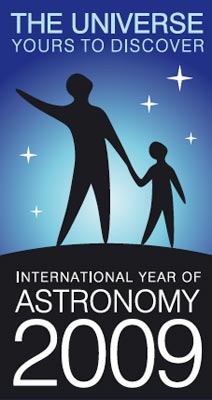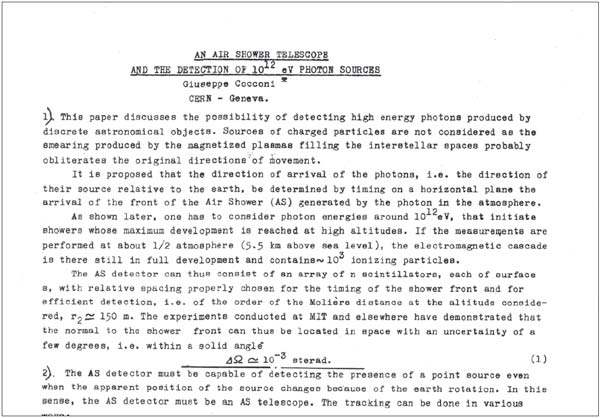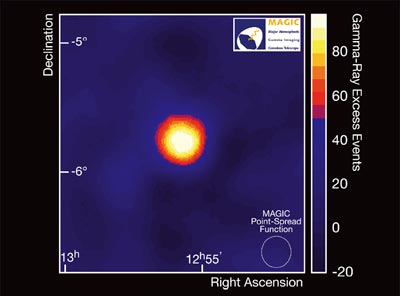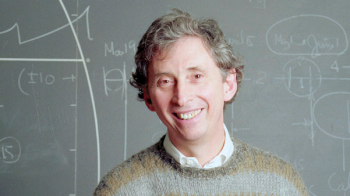Friends and colleagues reminisce on a remarkably perceptive physicist.

Image credit: ESO.
In 1938 Giuseppe Cocconi published his first paper, “On the spectrum of cosmic radiation”. His last unpublished note of December 2005 bore the title “Arguments in favour of a personal interpretation of extra galactic cosmic rays”. No better indication could be given of his deep interest in astronomy and astrophysics, which lasted until he died in November 2008 aged 94.
The fields that he pioneered are now witnessing exciting new developments. Over the past six months they have reminded us of his many contributions to physics; his simple, direct way to conceive and perform experiments; and his unique way of presenting the subjects that he loved. In this article we describe some of these events and recall what Giuseppe contributed to the various fields.
Ultra-high-energy cosmic rays

Image credit: Time & Life Pictures/Getty Images.
Giuseppe’s interest in the cosmos began when he was in his teens. He would design sundials for friends’ villas around his home town of Como, observe the sky and read as much about it as he could. Late one evening, he happened to observe the fall of some Perseid meteors at an unexpected time. Noting quickly their number and time he transmitted the information to a fellow astronomer – probably the first of his observations to be “published”.
He entered the cosmic-ray scene in February 1938 when he was invited to Rome for six months by Edoardo Amaldi and started working with Enrico Fermi on the construction of a cloud chamber to study cosmic radiation. When Giuseppe returned to Milan he continued to pursue his new interest in cosmic rays, in particular extensive air showers, using Geiger counters to detect them. This was to be the focus of his research for the next 22 years.

At the time, Pierre Auger had just begun his intensive investigations of air showers. Today this work is honoured in the name of the Pierre Auger Observatory, which is taking the study of the highest-energy cosmic rays to new levels through the detection of very widespread showers. In 1938, electromagnetic showers were understood; mesotrons (muons) were known, but not their interactions; and pions were yet to be discovered. The existence of multiple-particle showers, spread over many square metres, was known – nothing, however, of their origins and little about their composition.
Giuseppe’s work concentrated on the study of the composition of such showers – as a function of their lateral extent, zenith angle, and altitude – in experiments both at sea level and at 2200 m above sea level, at Passo Sella in the Dolomites. Many of these experiments were conducted with Vanna Tongiorgi, who became his wife in 1945. The couple moved to Cornell in 1947 and continued their experiments (some in collaboration with Kenneth Greisen) at Echo Lake on Mt Evans, Colorado, as well as at sea level and at 1600 m water equivalent underground. This vast range of experiments, from 1939 to 1958, contributed considerably to the understanding of cosmic-ray showers: they are produced by the interaction of high-energy nuclei – chiefly protons – with the nuclei of the upper atmosphere.
Even before the discovery of the feature called the “ankle” in the energy spectrum of the primaries in 1960s, Giuseppe realized clearly that the charged primaries with an energy in excess of 1019 eV must come from extragalactic sources because their radius of curvature in the galactic magnetic field is of the same order as the size of our galaxy. In a talk at the 5th International Cosmic Ray Conference (ICRC) in Guanajuato, Mexico, in 1955, he said: “These particles are cosmic, indeed, because even the galaxy seems too small to contain them.”
Giuseppe maintained his great interest in the physics of cosmic rays throughout his life. When he was informed that the Pierre Auger Observatory had started to operate in 2002 and had detected high-energy showers, he replied by writing “Mi ringiovanisci di cinquant’anni rinfrescando i miei primi amori (You make me 50 years younger by reminding me of my first love)”. His first love was, of course, the physics of cosmic rays. Jim Cronin, founder and first spokesperson of the observatory, recalls receiving “a wonderful congratulatory letter following our publication on 28 November 2007”, when the collaboration announced the discovery that active galactic nuclei are the most likely candidates for the source of the ultra-high-energy cosmic rays arriving on Earth. The discovery confirmed Giuseppe’s hypothesis from 50 years earlier that the highest-energy component in cosmic rays is of extragalactic origin. The Pierre Auger Observatory was inaugurated a year later, on 14 November 2008, only a few days after he passed away. One of us (GM), a long-time collaborator of Giuseppe, gave a speech as the current spokesperson of the collaboration.
Gamma rays from the cosmos

Image credit: MAGIC Collaboration.
The vast majority of cosmic-ray showers originate with charged primary particles, mainly protons and nuclei not heavier than iron, but a small fraction arise from the interaction of high-energy gamma rays in the atmosphere. At the 1959 ICRC in Moscow, while on leave at CERN from Cornell, Giuseppe suggested the possibility of detecting cosmic sources of high-energy photons using coincidence techniques to separate unidirectional photons from the isotropic background. He proposed that the Crab Nebula might be a strong source of gamma-rays in the tera-electron-volt range. The paper motivated Aleksandr Chudakov of the Lebedev Institute to build a pioneering gamma-ray telescope in the Crimea, designed to detect the short bursts of Cherenkov light generated in the atmosphere by extensive air showers, which had been first observed by Bill Galbraith and John Jelley at Harwell in the UK in 1953. Finally, in 1989, the Whipple air-Cherenkov telescope in the US detected the Crab Nebula as, indeed, a source of tera-electron-volt gamma rays.
Second-generation imaging air-Cherenkov telescopes (IACTs) – HESS, MAGIC and VERITAS – now cover the northern and southern hemispheres, detecting point-like and extended sources with a typical angular resolution of an arcminute. This means that galactic sources, such as supernova remnants (SNRs), can be imaged with a resolution smaller than their angular extension. A recent result from the HESS telescopes in Namibia on the emission from the nearest active galactic nucleus, Centaurus A, could explain the small cluster of a few events of ultra-high-energy cosmic rays that the Pierre Auger Observatory has observed in this direction.
Giuseppe enjoyed the discovery last year by MAGIC of very high-energy gamma rays from the active nucleus of the 3C279 galaxy. This quasar is at a distance of roughly half the radius of the universe, which is more than twice the distance of objects previously observed in gamma rays. The MAGIC Collaboration thus concludes that the universe appears more transparent at cosmological distances than previously believed, precluding significant contributions from light other than from sources observed by current optical and infrared telescopes.
The new IACTs are now complementing observations by gamma-ray telescopes in space. Giuseppe was interested in the results from two recent missions: AGILE, launched on 23 April 2007; and Fermi, launched on 11 June 2008. These missions are collecting important data on galactic and extragalactic sources in the energy range 100 MeV–100 GeV and should provide a wealth of information for understanding the sources of particle acceleration. These include gamma-rays bursts (GRBs), which are the highest-energy phenomena occurring in the universe since the Big Bang. It is no surprise that Giuseppe developed a recent interest in GRBs, reinforced by frequent discussions on the subject with Alvaro de Rújula at CERN. In 2008 the Fermi mission detected the most energetic GRB so far observed, GRB 080916C, at a distance of 12.2 thousand million light-years.
It was his interest in gamma rays that sparked the work for which Giuseppe became most widely known outside particle and astrophysics, after he and Philip Morrison (visiting CERN from Cornell) published a two-page article in Nature on “Searching for interstellar communications”. Morrison recalled that: “One spring day in 1959, my ingenious friend Giuseppe Cocconi came into my office and posed an unlikely question: would not gamma rays, he asked, be the very medium of communication between stars?” Morrison agreed but suggested that they should consider the entire electromagnetic spectrum. In the resulting paper they argued for searching around the emission frequency at 1420 MHz, corresponding to the 21 cm line of neutral hydrogen. Giuseppe contacted Sir Bernard Lovell at Jodrell Bank in the UK, which had the largest radio telescope at the time, but Lovell was sceptical, and nothing came of the proposal to devote some time towards searching for an extraterrestrial signal. The first radio search for an alien signal was left to others, initially to the Ozma project, which was started independently by Frank Drake in 1959. Later, the Search for Extraterrestrial Intelligence (SETI) became a serious research topic, capturing the public’s imagination. Now, anyone with a computer can contribute to the search through SETI@home.
Rising cross-sections
The letter quoted above written to one of us (GM) in 2002 ends as follows: “We do not yet know from where the local cosmic rays are coming. Will I live long enough to know? Move fast and keep me informed … Meanwhile cross-sections and scatterings continue their quiet life, following the new machine with the square of the logarithm.” The last sentence refers, of course, to the LHC and to the proton–proton total cross-section experiments planned by the TOTEM Collaboration. Giuseppe’s second main physics interest, after cosmic rays, was proton–proton scattering. This began at CERN at the PS in 1961, continuing at Brookhaven with measurements at the highest momentum transfer so far and, from 1971, at the Intersecting Storage Rings (ISR).
In 1965 Giuseppe proposed with Bert Diddens and Alan Wetherell the use of the first extracted proton beam from the PS to measure elastic and inelastic cross-sections. The first experiment was on proton–proton scattering with large momentum-transfer. A few years earlier the same group had measured the shrinking of the forward elastic peak. This discovery gave an enormous boost to the phenomenology of Regge poles, which was fashionable at the time. The ensuing interpretation of the energy dependence of the total hadron–hadron cross-sections in terms of Pomeron exchange predicted an almost constant value of the cross-section with energy – a high-energy regime called “asymptopia”, which seemed to be round the corner and would be characterized by increasing interaction radii and decreasing central opacity.

In 1970 Giuseppe’s group joined the Rome ISS group of two of us (UA and GM), who had proposed to the ISR Committee the measurement of elastic-scattering events through the detection of protons scattered only a few millimetres from a circulating-proton current of many amperes. The movable parts that contained the detectors were soon called “Roman pots”. Giuseppe very much enjoyed such a small and delicate experiment. He would spend long hours gluing together thin scintillators and measuring the position of the counters in the ISR reference frame with theodolites.
By applying the optical theorem, the CERN–Rome group found that the proton–proton cross-section rises with energy. The results were published together with a paper by the Pisa–Stony Brook collaboration, who had detected the same phenomenon by measuring the total interaction rate. In parallel, the movable pots were used to measure the interference between the Coulomb amplitude and the nuclear amplitude, which was discovered to be positive and rising with energy; a consequence – through dispersion relations – of the fact that the total cross-section continues to rise at collision energies that were not directly attainable at the ISR.
The ISR best-fit gave a total proton–proton cross-section that rose as the square of the logarithm of the energy, behaviour that was confirmed by later experiments with Roman pots at the SPS and the Tevatron. It was to this that Giuseppe was referring when he wrote of cross-sections “continuing their quiet life” while waiting for TOTEM. He may have been disappointed that most physicists did not seem to realize the importance of this discovery. In the 1960s, asymptopia dominated; essentially, nobody thought that the cross-sections could rise with energy. Even Vladimir Gribov made the hypothesis that they might be slowly decreasing, despite the observation at Serpukhov that the kaon–proton cross-section was increasing slightly. Some theoreticians – such as Marcel Froissart and André Martin, Nick Khuri and Tom Kinoshita – envisaged, from a purely mathematical point of view, that there could be a rising cross-section and tried to see the consequences. The only serious model was the one proposed by H Cheng and T T Wu in 1968.
Giuseppe was very interested in seeing what would be found in the new energy range and one of his last topics of conversation was the incident on 19 September that brought the commissioning of the LHC to a halt. He was clearly disappointed because he hoped to see proton–proton collisions at really high energies.
Unity in physics
Whenever he could Giuseppe would use accelerator data to illuminate an open problem in cosmic-ray physics, and vice versa. A typical example is the paper published with one of us (GB) in Nature in 1987 in which a relevant limit is put on the neutrino electric charge by calculating the dispersion of the time of flight of the neutrinos produced by SN1987a and detected by Kamiokande. He later applied a similar method to the photon pulses emitted by the millisecond pulsar PSR 1937+21 to get a limit on the photon’s electric charge.
His view of a basic unity in physical science, from galaxies to elementary particles, was clear in a series of lectures that he delivered at CERN more than 20 years ago. Following an invitation from André Martin, who at the time was chairperson of the Academic Training Committee, Giuseppe gave a course on “Correlations between high-energy physics and cosmology” in 1980. In these lectures he illustrated what he believed, at the time, were the important problems that could strengthen the relations between particle physics and cosmology – the field now known as astroparticle physics. The main themes of the past 20 years were all present: from the analysis of extragalactic emissions (with particular attention to the cosmic microwave background radiation) to the measurements of the deceleration parameter of the cosmic expansion. The series was so successful that the committee invited him to lecture again in 1984, this time on “A new branch of research: Astronomy of the most energetic gamma rays”. It, too, was a great success.
In a paper written to celebrate Edoardo Amaldi’s 60th birthday, Giuseppe expressed his continuing vision of science: “A common aim of people interested in science is that of improving the comprehension of phenomena that can be observed in the world.” Throughout his long life in science he made many contributions to improving this comprehension, through his particular approach to research. Many years after his retirement, he continued to impress younger colleagues at CERN, some of whom would hand him their recent papers for comments and advice, as Massimo Giovannini recalls. “His comments were always sharp and precise … for Giuseppe one aspect of research was the art of phrasing the complications of a phenomenon in simple numerical terms.” This was perhaps best summarized by Nobel laureate Sam Ting in his Nobel prize speech in 1976: “…I went to CERN as a Ford Foundation Fellow. There I had the good fortune to work with Giuseppe Cocconi at the Proton Synchrotron, and I learned a lot of physics from him. He always had a simple way of viewing a complicated problem, did experiments with great care and impressed me deeply.”
• The authors are grateful to Jack Steinberger and André Martin for contributions on Cocconi’s cosmic-ray experiments and on the meaning of the discovery of the rising proton–proton cross-section.








